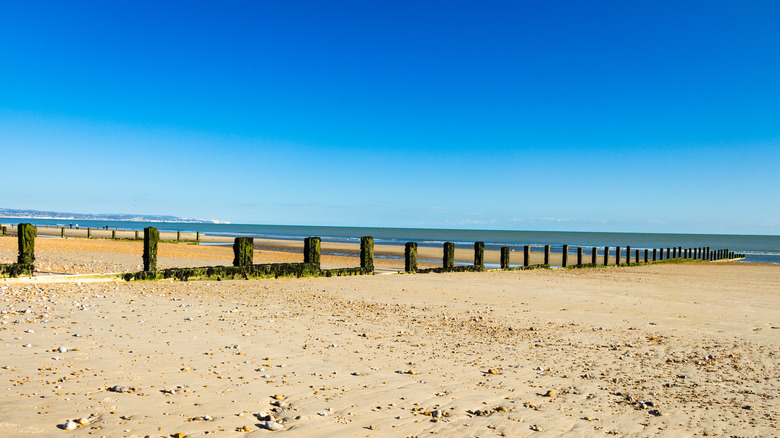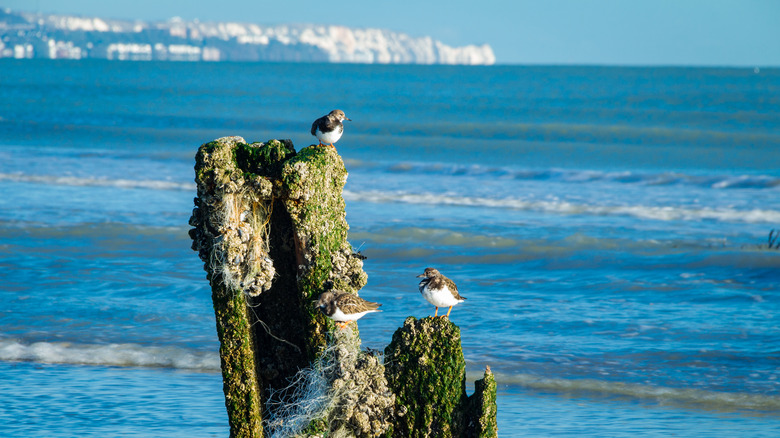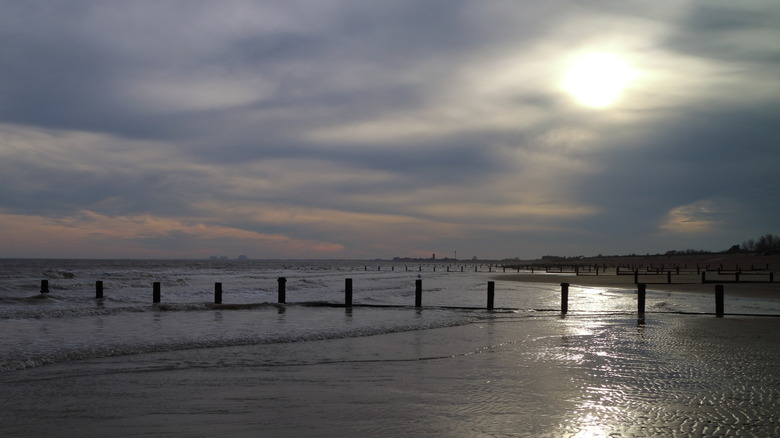Why You Should Think Twice Before Swimming At This UK Beach
Venturing into the sea in the U.K. has always been reserved for those who prefer their dips of the bracing variety. Even in the summer, water temperatures around Britain's coast rarely get above 20 degrees Celsius. That comes with the territory, but in recent years, there has been another reason to think twice about swimming at these beaches: pollution. Thanks to the nation's antiquated sewage system, combined with post-Brexit regulations altering the legal limits of raw sewage dumped in U.K. waterways, many beaches now suffer from a deluge of effluent. Dozens of spots around the coast have the same problem, but one location in particular has been identified as the most polluted: St. Mary's Bay in Kent.
It's a sad problem for a nation where a trip to the seaside still holds a special place in the hearts of so many people. The glory days of the classic British summer holiday may be a thing of the past, but a stroll along the beach or promenade, followed by some fish and chips, is still a popular pastime for young and old. You're never more than 70 miles away from the sea in Britain, and the coast is dotted with hundreds of great beach towns ranging from popular day trips from London to Brighton and Dover, to cozy fishing villages like Mousehole and Walberswick. But as the case of St. Mary's Bay shows, actually going into the sea is becoming increasingly hazardous.
St. Mary's Bay received a year-long no swimming warning
St. Mary's Bay is a peaceful coastal village on Romney Marsh, a swathe of wetlands that separates the isolated shingle headland at Dungeness from the rest of the county. The area has been popular with vacationers since the 1920s, as there were several holiday camps in the region, and today the long crescent of golden sands is still a draw for families for a day by the seaside.
Unfortunately, taking to the same waters nowadays could prove seriously bad for your health — in February 2023, the Environmental Agency issued a year-long warning for St. Mary's Bay after hazardous levels of bacteria were found in the sea. Aside from the obvious grossness of swimming in water contaminated by sewage, it can cause various symptoms and illnesses, from infections and fever to more serious conditions like salmonella, E.coli, and Hepatitis A.
The Bay is a lot quieter now than it was in its heyday, but it still attracts visitors with the prospect of sand castles, ice cream, and perhaps a donkey ride for the kids. Needless to say, becoming the only beach in Kent to receive a "do not swim" warning affects the area's seasonal trade, and the EA pledged to investigate the source of the harmful bacteria.
St. Mary's Bay is not the only place with pollution problems
At the time of writing, St. Mary's Bay still carries a no-swim warning, although a source at the Parish Council has pointed out there is no actual ban in place. Unlike some beaches in the U.K. with long-running pollution issues, such as Staithes in Yorkshire, water quality at St. Mary's Bay was classified as good to sufficient until recent years. It is also not the only part of Kent that has suffered from pollution as of late. In June 2023, people were warned not to swim at Herne Bay as well.
Just along the coast at Tankerton Beach, U.K. chart-topper Feargal Sharkey and former boxer Barry McGuigan led protests in September 2023 against Southern Water (a U.K. utility company) discharging waste into the sea nearby. Unfortunately, this means that even beaches carrying the Blue Flag (a mark of water cleanliness and safety) aren't immune from sewage problems.
If you're planning a trip to the British coast, you can check live pollution alerts at Surfers Against Sewage before venturing into the water. It is also important to point out that this article shouldn't discourage you from visiting St. Mary's Bay or any other place along the U.K. coast. Even if you can't go in the water, a day at the seaside with a nice walk along the promenade and a bite to eat still makes for a wonderful experience.


